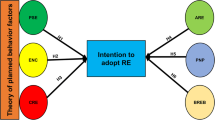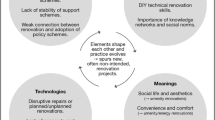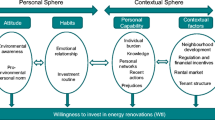Abstract
Guided by the theory of planned behaviour, we conducted an interview study to identify beliefs that potentially influence social-housing residents’ future behaviour with domestic low-carbon technology in retrofit housing. The study included (group interview n = 6, individual interviews n = 14). Behavioural beliefs, normative beliefs and control beliefs were identified from participants’ answers using the theory of planned behaviour and thematic analysis. For successful implementation, it will be important to ensure that the predominant benefits (positive beliefs) emerging from this study are implemented (e.g., lower heating bills) and the barriers (negative beliefs) are avoided or alleviated (e.g., upfront costs). The results will be quantified in a follow-up, survey study.
You have full access to this open access chapter, Download conference paper PDF
Similar content being viewed by others
Keywords
24.1 Introduction
One of the measures to alleviate the effects of global warming currently under consideration is residential decarbonisation. Technical solutions (heat pump, solar panel, battery energy storage systems) are available, but initiatives that do not consider residents’ acceptance will not be successful. Psychological theories and models such as the theory of planned behaviour and the technology acceptance model [1] provide tools that allow us to qualitatively identify beliefs that guide human behaviour with technology [2] and quantitatively predict behaviour [3]. The aim of the current study is therefore to identify beliefs that potentially guide social-housing residents’ future behaviour with domestic low-carbon technology. The objectives are to identify behavioural beliefs (a person's subjective probability that performing a behaviour of interest will lead to a certain outcome or provide a certain experience), normative beliefs (injunctive normative belief: the expectation or subjective probability that a given referent individual or group approves or disapproves of performing the behaviour under consideration; descriptive normative belief, belief as to whether important others themselves perform the behaviour) and control beliefs (about the presence of factors that can facilitate or impede performance of the behaviour) that may underly residents’ behaviour with domestic low-carbon technology according to the theory of planned behaviour [1], as well as any other beliefs.
24.2 Methodology and Theory
Participants. Twenty participants were recruited via two methods: email and social media. Potential participants could either respond to a dedicated email address or complete an online form, both of which were monitored for responses collected; participants were subsequently contacted by email or phone. All were offered either an online interview via VoIP or a face-to-face interview in their own home. The twenty participants (6 in a group interview and 14 in individual interviews) consisted of tenants, a mixture of men (10) and women (9), with an age range from 26–75. All residents lived in the Tees Valley in the north-east of England.
Group interview. Before the questions (see Table 24.1), the participants listened to a short presentation on global warming and UK climate change targets. It was explained how low-carbon homes, a critical part of the UK’s efforts, are to meet climate change. At the start of the interview, participants were further presented with still images and a short video of a model retrofit home with explanatory live commentary, that demonstrated how a low-carbon technology home would look. The walkthrough video was created by Teesside University’s School of Computing, Engineering and Digital Technologies using Autodesk REVIT, 3D modelling software.
Semi-structured questions with open answers (see Table 24.1), based on the theory of planned behaviour, were used to encourage discussion of ideas. The theory of planned behaviour is appropriate to use in this research, as the theory accounts for beliefs that guide human behaviour (behavioural beliefs, normative beliefs and control beliefs) [1] and has been used to qualitatively understand [2] and quantitatively predict [3] people’s use of technology. In this study, the benefits of conducting a group interview were to ensure the questions were understood and the other tools used, i.e., video, were effective for purpose [4]. As the Interview guide or questions are the main tool for providing consistency in the generation of qualitative data and, consequently, the conclusion of the research [5], this group interview was carried out as a pre-cursor to individual interviews.
Individual interviews. The procedure was adapted from the group interview. The participants were shown the pre-recorded presentation, including the content of both group interview presentations; then followed a short testimonial, from a tenant with low-carbon technology already installed. (The decision to include this testimonial was made following the results from the group interview where ‘lived experience’ of tenants currently using low-carbon technology was a high priority for potential acceptance). The interview questions (Table 24.1) were then asked.
The interviews were conducted and transcribed verbatim by five researchers. In order to avoid preconceptions and bias, three researchers analysed the data from the interviews, checking results against one another to come to a final agreement; this increased the credibility and trustworthiness of the results.
24.2.1 Data Analysis
Thematic analysis [6] was applied to the data sets and deductive coding began with the theory of planned behaviour belief questions on low-carbon homes to identify the broad, overarching emergent themes. Iterative coding included searching the data for relationships, similarities and differences and beginning to organise these into themes. Within the coding and themes, comparisons, frequency and elaborations were considered for determinants of behaviour and specific emerging themes [6]. The three researchers compared and reached a consensus on the codes and themes included in the results, and another researcher checked these for clarity.
24.3 Results and Discussion
Group interview. Four themes identified were unique to the group interview: participants expressed the desire to experience how the heat pump system would look and work inside their own home when installed. As lived experience of residents currently using the technology was a high priority for them, a testimonial was suggested. This feedback was incorporated into the individual face-to-face interviews and proved effective as these specific themes did not arise in this cohort. Participants expressed their wish to have choice in which place, if any, low-carbon technologies they would like installed—this may be due tenants fearing increased rent as a result. The questions of noise from the system and possible vandalism were also raised. The participants discussed the issue of skills gaps within the energy sector and suggested upskilling of current staff—this was seen as an opportunity to create new opportunities and jobs (Table 24.2).
Individual interviews. Control beliefs, behavioural beliefs, normative beliefs and other themes were identified (Table 24.3). Control Beliefs: environmental and climate change benefits were cited by almost all participants as the main motivator along with the benefits of lower running costs. Upfront costs were viewed as a barrier by five participants, but this was mostly likely from the point of view of self-funding the system. Retrofitting was viewed as a motivator, providing insulation was sufficient for effectiveness of the system. Further information regarding fitting the systems into multi-occupancy building or flats would improve motivation. Behavioural Beliefs: lower running costs were cited by almost all participants as a huge benefit; only two participants expressed concern around cost; environmental benefits were viewed, alongside this, as a major advantage. Solar energy was regarded positively and as a free energy source. Temperature regulation was seen as an advantage, especially if it could be controlled and included the ability to provide zoned heating. Loss of storage space in the home was mentioned, along with the issue of maintenance. A few participants were concerned with technology flaws—these fears could be reduced by providing further information and engaging with tenants. Normative Beliefs: most participants believed that nobody would disapprove of or refuse the opportunity to live in a low-carbon home. Other themes: political—the issues surrounding renewables and the environment were viewed as complex, with confusing and conflicting information given to the public, but regardless of this most people were willing to engage in environmentally friendly initiatives. It was felt that a national plan is required, which includes low-carbon housing. Some participants felt that they did not have enough information to decide on whether low-carbon technology would function correctly or be suitable within their home.
24.4 Conclusion
Based on our findings, housing association tenants may benefit from clear, transparent information (e.g. from others who have experience of living in a low-carbon home) and support throughout the whole process, before, during and after fitting of low-carbon technologies. Specifically, they may profit from information about the benefits (e.g. improved health) and facilitators (e.g. potential savings on running costs) of changing to a low-carbon home. They may also benefit from information about the potential disadvantages (e.g. any flaws in the technology) and barriers (e.g. pre-requisites such as good home insulation), and explanation of how these can be overcome and refutation of any that are not true. Successful interaction between the new energy technology and the individual [7] could be encouraged by including different audiences and social groups and to consider individuals, while making efforts to adapt to their reality.
References
I. Ajzen, The theory of planned behavior: frequently asked questions. Hum. Behav. Emerg. Technol. 2(4), 314–324 (2020). https://doi.org/10.1002/hbe2.195
K.M. White et al., Identifying safety beliefs among Australian electrical workers. Saf. Sci. 82, 164–173 (2016). https://doi.org/10.1016/j.ssci.2015.09.008
Q. Deng, Y. Zheng, J. Lu, Z. Zeng, W. Liu, What factors predict physicians’ utilization behavior of contrast-enhanced ultrasound? Evidence from the integration of the theory of planned behavior and technology acceptance model using a structural equation modeling approach. BMC Med. Inform. Decis. Mak. 21(1) (2021). https://doi.org/10.1186/s12911-021-01540-8
L. Harvey, Social research glossary social research glossary. Soc. Res. 2022 [Online]. Available: http://www.qualityresearchinternational.com/socialresearch/knowledge.htm
N.I.A. Gani, M. Rathakrishnan, H.N. Krishnasamy, A pilot test for establishing validity and reliability of qualitative interview in the blended learning English proficiency course. J. Crit. Rev. 7(5), 140–143 (2020). https://doi.org/10.31838/jcr.07.05.23
V. Braun, V. Clarke, Using thematic analysis in psychology. Qual. Res. Psychol. 3(2), 77–101 (2006). https://doi.org/10.1191/1478088706qp063oa
N. DellaValle, A. Bisello, J. Balest, In search of behavioural and social levers for effective social housing retrofit programs. Energy Build. 172, 517–524 (2018). https://doi.org/10.1016/j.enbuild.2018.05.002
Acknowledgements
The authors are grateful to Thirteen Housing Group Limited for access to their residents for the recruitment of participants. The authors are also thankful to UK Community Renewal Fund for financially supporting this research.
Author information
Authors and Affiliations
Corresponding author
Editor information
Editors and Affiliations
Rights and permissions
Open Access This chapter is licensed under the terms of the Creative Commons Attribution 4.0 International License (http://creativecommons.org/licenses/by/4.0/), which permits use, sharing, adaptation, distribution and reproduction in any medium or format, as long as you give appropriate credit to the original author(s) and the source, provide a link to the Creative Commons license and indicate if changes were made.
The images or other third party material in this chapter are included in the chapter's Creative Commons license, unless indicated otherwise in a credit line to the material. If material is not included in the chapter's Creative Commons license and your intended use is not permitted by statutory regulation or exceeds the permitted use, you will need to obtain permission directly from the copyright holder.
Copyright information
© 2023 The Author(s)
About this paper
Cite this paper
van Schaik, P. et al. (2023). Towards the Tees Valley Energy Transition—Residential Decarbonisation and Skills Analysis. In: Nixon, J.D., Al-Habaibeh, A., Vukovic, V., Asthana, A. (eds) Energy and Sustainable Futures: Proceedings of the 3rd ICESF, 2022. ICESF 2022. Springer Proceedings in Energy. Springer, Cham. https://doi.org/10.1007/978-3-031-30960-1_24
Download citation
DOI: https://doi.org/10.1007/978-3-031-30960-1_24
Published:
Publisher Name: Springer, Cham
Print ISBN: 978-3-031-30959-5
Online ISBN: 978-3-031-30960-1
eBook Packages: EnergyEnergy (R0)




